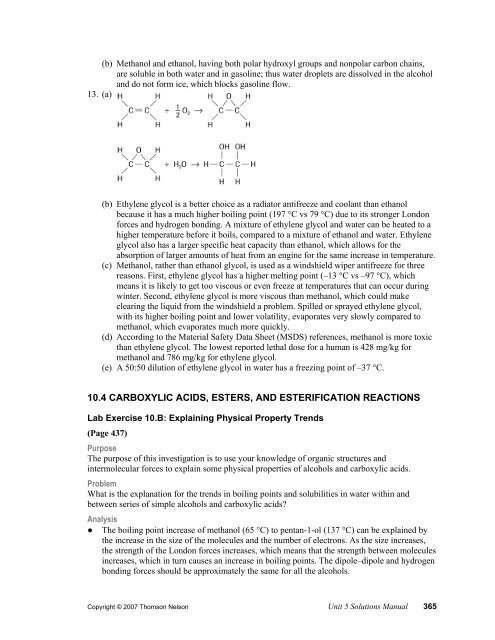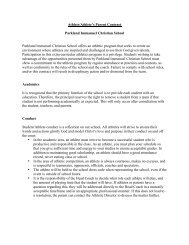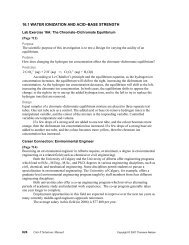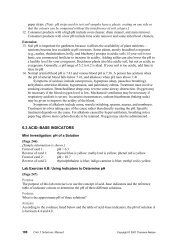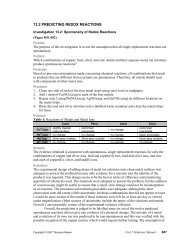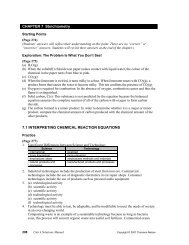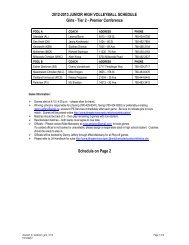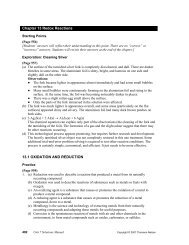10.4 CARBOXYLIC ACIDS ESTERS AND ESTERIFICATION REACTIONS
10.4 carboxylic acids, esters, and esterification reactions
10.4 carboxylic acids, esters, and esterification reactions
Create successful ePaper yourself
Turn your PDF publications into a flip-book with our unique Google optimized e-Paper software.
(b) Methanol and ethanol, having both polar hydroxyl groups and nonpolar carbon chains,<br />
are soluble in both water and in gasoline; thus water droplets are dissolved in the alcohol<br />
and do not form ice, which blocks gasoline flow.<br />
13. (a)<br />
(b) Ethylene glycol is a better choice as a radiator antifreeze and coolant than ethanol<br />
because it has a much higher boiling point (197 °C vs 79 °C) due to its stronger London<br />
forces and hydrogen bonding. A mixture of ethylene glycol and water can be heated to a<br />
higher temperature before it boils, compared to a mixture of ethanol and water. Ethylene<br />
glycol also has a larger specific heat capacity than ethanol, which allows for the<br />
absorption of larger amounts of heat from an engine for the same increase in temperature.<br />
(c) Methanol, rather than ethanol glycol, is used as a windshield wiper antifreeze for three<br />
reasons. First, ethylene glycol has a higher melting point (–13 °C vs –97 °C), which<br />
means it is likely to get too viscous or even freeze at temperatures that can occur during<br />
winter. Second, ethylene glycol is more viscous than methanol, which could make<br />
clearing the liquid from the windshield a problem. Spilled or sprayed ethylene glycol,<br />
with its higher boiling point and lower volatility, evaporates very slowly compared to<br />
methanol, which evaporates much more quickly.<br />
(d) According to the Material Safety Data Sheet (MSDS) references, methanol is more toxic<br />
than ethylene glycol. The lowest reported lethal dose for a human is 428 mg/kg for<br />
methanol and 786 mg/kg for ethylene glycol.<br />
(e) A 50:50 dilution of ethylene glycol in water has a freezing point of –37 °C.<br />
<strong>10.4</strong> <strong>CARBOXYLIC</strong> <strong>ACIDS</strong>, <strong>ESTERS</strong>, <strong>AND</strong> <strong>ESTERIFICATION</strong> <strong>REACTIONS</strong><br />
Lab Exercise 10.B: Explaining Physical Property Trends<br />
(Page 437)<br />
Purpose<br />
The purpose of this investigation is to use your knowledge of organic structures and<br />
intermolecular forces to explain some physical properties of alcohols and carboxylic acids.<br />
Problem<br />
What is the explanation for the trends in boiling points and solubilities in water within and<br />
between series of simple alcohols and carboxylic acids?<br />
Analysis<br />
The boiling point increase of methanol (65 C) to pentan-1-ol (137 C) can be explained by<br />
the increase in the size of the molecules and the number of electrons. As the size increases,<br />
the strength of the London forces increases, which means that the strength between molecules<br />
increases, which in turn causes an increase in boiling points. The dipole–dipole and hydrogen<br />
bonding forces should be approximately the same for all the alcohols.<br />
Copyright © 2007 Thomson Nelson Unit 5 Solutions Manual 365
The decrease in solubility of alcohols in water comes from the addition of CH 2 groups to the<br />
alcohol. The more CH 2 groups added to the parent chain, the greater the nonpolar portion of<br />
the alcohol and the less its solubility.<br />
The boiling point increase of methanoic acid (101 C) to pentanoic acid (186 C) can be<br />
explained by the increase in the size of the molecules and the number of electrons. As the size<br />
increases, the strength of the London forces increases, which means that the strength between<br />
molecules increases, which in turn causes an increase in boiling points. The dipoledipole<br />
and hydrogen bonding forces should be approximately the same for all the acids.<br />
The decrease in solubility of carboxylic acids in water comes from the addition of CH 2<br />
groups to the acid. The more CH 2 groups added to the parent chain, the greater the nonpolar<br />
portion of the acid and lower its solubility.<br />
The carboxylic acids as a group have a higher set of boiling points than alcohols and are<br />
generally more soluble in water. The carboxylic acid group is more polar than the hydroxyl<br />
group on the alcohol and there are more locations available for hydrogen bonding.<br />
Evaluation<br />
The purpose was accomplished because the explanation for trends in boiling points and<br />
solubilities of alcohols and carboxylic acids seems to be logical and consistent with<br />
intermolecular theories and rules. There are no exceptions or unexplained results.<br />
Practice<br />
(Page 438)<br />
1. (a)<br />
(b)<br />
(c)<br />
2. (a) methanoic acid (formic acid)<br />
(b) pentanoic acid<br />
(c) hexanoic acid<br />
Practice<br />
(Pages 441–442)<br />
[Note that the ester functional group is –COO– and the general formula for an ester is<br />
R 1 (H)–COO–R 2 .]<br />
3. (a) rum flavour<br />
366 Unit 5 Solutions Manual Copyright © 2007 Thomson Nelson
(b) cherry flavour<br />
(c) apple flavour<br />
(d) banana flavour<br />
4. (a) ethyl propanoate (from propanoic acid and ethanol)<br />
(b) methyl butanoate (from butanoic acid and methanol)<br />
(c) butyl methanoate (from methanoic acid and butan-1-ol)<br />
(d) propyl ethanoate (from ethanoic acid and propan-1-ol)<br />
5. (a) pentan-1-ol and butanoic acid make pentyl butanoate<br />
(b) octan-1-ol and ethanoic acid make octyl ethanoate<br />
6. (a) The boiling points of the three classes of straight-chain organic compounds increase as<br />
the number of CH 2 groups are added to the parent chain. This occurs because as the<br />
number of electrons increases, the London force increases, increasing the total<br />
intermolecular forces and increasing the boiling point. Dipole–dipole forces and<br />
hydrogen bonding (acids) are assumed to be constant within a group.<br />
(b) At lower molar masses, the esters have slightly higher boiling points than alkanes<br />
because their molecules are polar with a small additional dipole–dipole force. However,<br />
as the size of the ester increases, the nonpolar portion of the molecules increases and the<br />
dipole–dipole forces become a much smaller part of the total intermolecular forces<br />
present. Since there is no hydrogen bonding, and there are only slight dipole–dipole<br />
forces, the strength of the intermolecular forces is similar for the same length of parent<br />
chain.<br />
(c) Carboxylic acids have higher boiling points than the alkanes or methyl esters of similar<br />
molar mass because they have additional hydrogen bonding forces, which the alkanes and<br />
methyl esters do not have.<br />
(d) The intermolecular force theories pass the test of being able to explain the relative boiling<br />
points, but an anomaly appears. At approximately 110 g/mol, the alkanes, with no<br />
dipole–dipole bonding, start to have a slightly higher boiling point than the straight chain<br />
methyl esters. This cannot be explained by our present knowledge.<br />
(e) The test is restricted to straight-chain compounds to try to keep other variables (like<br />
shape) constant. [Changing the shape of the compound greatly complicates the<br />
intermolecular forces between the molecules. Since the intermolecular forces depend on<br />
how close the molecules are to each other, the branches keep us from making accurate<br />
predictions.]<br />
(f) Since alcohols contain hydroxyl groups, which can form hydrogen bonds, the alcohols<br />
will have a higher boiling point, for a similar molar mass, than the alkanes and methyl<br />
esters. The alcohols will have a lower boiling point, for a similar molar mass, than the<br />
carboxylic acids because the extra carbonyl group on the acid will add more dipole–<br />
dipole forces and some additional locations for hydrogen bonding.<br />
Copyright © 2007 Thomson Nelson Unit 5 Solutions Manual 367
(g) The prediction posed in 6(f) is verified as the boiling points of alcohols are between the<br />
carboxylic acids and the alkanes and methyl esters.<br />
7. Pro Perspectives<br />
Ecological: It is less wasteful to produce artificial flavours than to extract the flavour<br />
from natural sources and discard any unused parts.<br />
Esthetic: Artificial flavours have a more consistent flavour between batches, keeping<br />
products tasting the same for consumers over time.<br />
Con Perspectives<br />
Ecological: The production of artificial flavours uses up petrochemicals, which are a<br />
nonrenewable resource.<br />
Esthetic: Many consumers feel that artificial flavours do not taste as good as the flavours<br />
they are replacing.<br />
Investigation 10.3: Synthesis of an Ester<br />
(Pages 442, 463)<br />
Purpose<br />
The purpose of this investigation is to use the esterification generalization and diagnostic tests to<br />
synthesize and observe the properties of two esters.<br />
Problem<br />
What are some physical properties of ethyl ethanoate (ethyl acetate) and methyl salicylate?<br />
Evidence/Analysis<br />
Ester Solubility Odour<br />
ethyl ethanoate liquids mixed sweet, “gluey” smell<br />
methyl salicylate two layers formed wintergreen smell<br />
Investigation <strong>10.4</strong>: Testing with Models<br />
(Pages 442, 464)<br />
[Prediction and Evaluation should not be required. The purpose should be to obtain a better<br />
understanding of a variety of organic reactions by building and observing molecular models.<br />
Orientation of molecules is important in many organic reactions, and the stereochemical<br />
formulas provide a method of recording this information.]<br />
Purpose<br />
The purpose of this investigation is to test stereochemical formula equations by using molecular<br />
models.<br />
Problem<br />
What are the stereochemical formula equations for the following reactions?<br />
(a) methane undergoes complete combustion<br />
(b) ethane is cracked into ethane<br />
(c) propane reacts with chlorine<br />
(d) but-2-ene reacts with water<br />
(e) ethanol eliminates water to produce ethane<br />
(f) 1-chloropropane undergoes an elimination reaction with hydroxide ions to produce propene, a<br />
chloride ion, and water<br />
(g) ethanol reacts with methanoic acid<br />
368 Unit 5 Solutions Manual Copyright © 2007 Thomson Nelson
Prediction<br />
[This is not required.]<br />
Materials<br />
Molecular model kit, molecular model software program, or Internet virtual models.<br />
Evidence<br />
(a)<br />
(b)<br />
(c)<br />
(d)<br />
(e)<br />
(f)<br />
(g)<br />
Copyright © 2007 Thomson Nelson Unit 5 Solutions Manual 369
Section <strong>10.4</strong> Questions<br />
[This is not required.]<br />
(Pages 443–444)<br />
1.<br />
Family General formula Naming system<br />
(a) Alcohols ROH [prefix]an-#-ol<br />
(b) Carboxylic acids RCOOH [prefix]anoic acid<br />
(c) Esters R 1 COOR 2 [prefix]yl [prefix]anoate<br />
2. An ester contains an —OR group in place of the —OH in the carboxylic acid. The OH group<br />
is responsible for the acidic properties of carboxylic acids, and also for hydrogen bonding;<br />
thus esters have lower melting and boiling points, are less soluble in water, and are less<br />
acidic.<br />
3. Procedure<br />
1. In a test tube, mix 5 mL of ethanol and acetic acid.<br />
2. In a fume hood, add 8–10 drops of concentrated sulfuric acid.<br />
3. Heat test tube and contents in a hot-water bath for 10–15 min, with a small beaker<br />
inverted over the test tube.<br />
4. Cool and observe contents.<br />
5. Dispose of the mixture into the sink with lots of cold water.<br />
CAUTION: Concentrated sulfuric acid is highly corrosive. Avoid contact with skin and<br />
clothing. Wear eye protection and a lab apron. Work under a fume hood and keep test tubes<br />
in a hot-water bath, away from people. Ethanol is flammable, so there should be no open<br />
flames in the vicinity.<br />
4. (a) HNO 3 + NaOH NaNO 3 + H 2 O<br />
nitric acid + sodium hydroxide sodium nitrate + water<br />
CH 3 COOH + CH 3 CH 2 CH 2 OH CH 3 COOCH 2 CH 2 CH 3 + H 2 O<br />
ethanoic acid + propan-1-ol propyl ethanoate + water<br />
Both inorganic salts and esters are formed by combining part of the reactant acid and the<br />
other “OH” reactant. Water is a product of both reactions. However, the inorganic salt is<br />
an ionic compound and the ester is a molecular compound.<br />
(b) The two unlabelled samples are observed or tested for state of matter, solubility in water,<br />
conductivity of solution, and flame test of the solution or pure sample.<br />
5. (a) (b)<br />
370 Unit 5 Solutions Manual Copyright © 2007 Thomson Nelson
(c)<br />
6. (a) Neutralization<br />
(b) Esterification<br />
(c) Neutralization<br />
(d) Esterification<br />
7.<br />
8. (a)<br />
(b)<br />
Copyright © 2007 Thomson Nelson Unit 5 Solutions Manual 371
(c)<br />
(d)<br />
(e)<br />
(f)<br />
(g)<br />
9. Purpose<br />
The purpose of this investigation is to test the esterification reaction generalization.<br />
Problem<br />
What is the product of the reaction between benzoic acid and ethanol?<br />
Prediction<br />
According to the esterification reaction generalization,<br />
372 Unit 5 Solutions Manual Copyright © 2007 Thomson Nelson
Materials<br />
lab apron pure ethanol dropper bottle<br />
eye protection concentrated sulfuric acid<br />
two 25250 mm test tubes vial of benzoic acid<br />
250 mL beaker two 50 mL beakers<br />
laboratory scoop balance<br />
hot plate thermometer<br />
ring stand test tube clamp<br />
CAUTION:<br />
Concentrated sulfuric acid is dangerously corrosive. Protect your eyes and do not allow<br />
the acid to come in contact with skin, clothes, or paper.<br />
Ethanol is flammable. Keep ethanol away from open flame and from direct contact with<br />
the hot plate element.<br />
Excessive inhalation of the products may cause headaches or dizziness. Use your hand to<br />
waft the odour from the cooled test tube towards your nose. The laboratory area should<br />
be well ventilated.<br />
Analysis<br />
According to the evidence, the odour of cherries and the low solubility are both positive tests<br />
for the presence of ethyl benzoate ester.<br />
Evaluation<br />
On the basis of the limited evidence collected, it appears that the prediction is verified but the<br />
results are not very certain. Therefore, the esterification reaction generalization remains<br />
acceptable because no evidence was obtained to contradict it. The purpose was not really<br />
accomplished because the design was limited and only one reaction was investigated.<br />
Additional reactions with better tests need to be investigated.<br />
10. (a) C 25 H 51 COOH + C 32 H 63 OH C 25 H 51 COOC 32 H 63 + H 2 O<br />
(b) C 27 H 55 COOH + C 30 H 61 OH C 27 H 55 COOC 30 H 61 + H 2 O<br />
11. Pro Perspective<br />
Technological:Many carboxylic acids and esters are easier to produce artificially than to<br />
recover from natural products.<br />
Con Perspectives<br />
Mystical: Some people believe that natural sources of carboxylic acids like vitamin C are<br />
inherently better than manufactured sources because they are natural.<br />
Esthetic: Artificial flavours of synthetic esters are only approximate and are not as<br />
flavoursome as the natural product.<br />
Copyright © 2007 Thomson Nelson Unit 5 Solutions Manual 373
Extension<br />
12. (a)<br />
(b) Animal hides decompose quickly unless they are cured to remove the water from the<br />
skin. The hide is first soaked in water to remove water-soluble substances, and hair is<br />
removed by soaking in a mixture of lime and water, followed by an enzyme mixture. The<br />
hair and any remaining tissue are removed by machine and the hide is washed and treated<br />
with tannic acid. The tannic acid displaces water from the spaces between the protein<br />
fibres of the hide, allowing the fibres to cement together to form a strong, water-resistant<br />
leather.<br />
13. (a) First molecule: one cis and two trans<br />
Second molecule: two cis and two trans<br />
(b) Transfats increase the level of low-density lipoprotein (LDL) or “bad” cholesterol in the<br />
bloodstream, which contributes to clogging of the arteries. As arteries clog, the risk of<br />
stroke and heart attack increases.<br />
10.5 POLYMERIZATION <strong>REACTIONS</strong>—MONOMERS <strong>AND</strong> POLYMERS<br />
Web Activity: Web Quest—Teflon: Healthy or Hazardous?<br />
(Page 448)<br />
[Students’ presentations may cover some of the following material.]<br />
Production of Teflon<br />
To produce polytetrafluoroethylene (PTFE or Teflon®), the manufacturer first needs a steady<br />
supply of tetrafluoroethylene (TFE). To produce the required TFE, three main ingredients,<br />
fluorspar, hydrofluoric acid, and chloroform are combined in a reaction chamber and heated to<br />
between 590 ˚C and 900 ˚C. The gas produced is cooled and then distilled to remove impurities.<br />
A possible sequence of reactions is:<br />
CaF 2 (s) + H 2 SO 4 (aq) CaSO 4 (s) + 2 HF(aq)<br />
CH 4 (g) + 3 Cl 2 (g) CHCl 3 (g) + 3 HCl(g)<br />
CHCl 3 (g) + 2 HF(g) CHClF 2 (g) + 2 HCl(g)<br />
2 CHClF 2 (g) CF 2 CF 2 (g) + 2 HCl(g)<br />
374 Unit 5 Solutions Manual Copyright © 2007 Thomson Nelson


